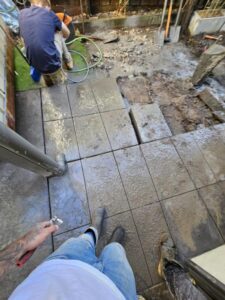Cutting expansion joints into your concrete driveway is essential because they allow for thermal expansion and contraction caused by temperature changes. These joints prevent cracks by providing controlled points for the concrete to expand or contract, thereby maintaining its integrity and appearance.
Over time, without these joints, large, unsightly cracks could develop, leading to costly repairs. Concreters understand the importance of this process and ensure that these joints are strategically placed for maximum effectiveness.
In this post, we’ll discuss and answer the most common questions about expansion joints in concrete driveways.
Do I Need Expansion Joints in Concrete Driveway?
Yes, you need expansion joints in your concrete driveway. Despite being recommended for driveways being more than 6 metres wide, these joints provide stability and longevity you need for a long-lasting driveway.
These expansion joints are also fundamental in areas that experience regular traffic or heavy loads.
What Happens If You Don’t Cut Expansion Joints in Concrete?
A concrete surface that doesn’t have expansion joints won’t be able to expand and contract as needed. This can result in the structure buckling or cracking, affecting its appearance and possibly becoming a safety hazard.
Furthermore, failing to add expansion joints in concrete can lead to its slabs failing, which will be expensive to fix.

How Far Apart Should Driveway Expansion Joints Be?
Your driveway expansion should be placed every 6 to 7 metres in general. Concrete driveways that are wider than 6 metres or located near a building will need to reduce each joint’s spacing to every 3 metres.
When Should I Cut Expansion Joints in a Concrete Driveway?
You should cut expansion joints in a concrete driveway as soon as it has sufficiently hardened to support the weight of a saw. This period can take around 24 to 48 hours after pouring the concrete.
It’s essential to cut expansion joints while the concrete still hasn’t hardened too much. Failing to cut the joints on time can cause them to crack or weaken.
What Are the Main Methods of Saw Cutting?
The main methods of saw cutting expansion joints are:
Dry Cutting
Dry cutting is the method of cutting joints in concrete without using water. Instead, a concreter will use a dry-cutting saw to cut through the concrete.
Wet Cutting
The other type of saw cutting that involves the use of water is called wet cutting. The liquid in this approach is meant to lubricate and cool the saw blade used to cut the expansion joints.
How Deep Should the Concrete Cuts Be?
The concrete cuts in expansion joints should be at least ¼ deep. It shouldn’t be more than half the thickness of the slab.
This is the generally accepted standard for most concrete installation providers.






